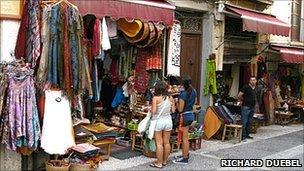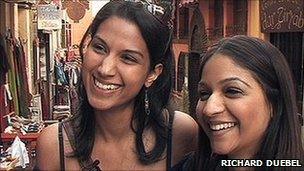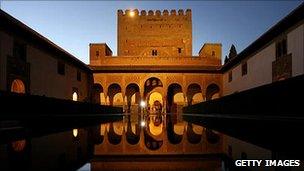'Moorish revival' in southern Spain
- Published
For hundreds of years, North African Muslims ruled southern Spain. Now some of their descendants are contributing to a "Moorish revival" that is regenerating parts of Andalucia, says the BBC's Sylvia Smith.

Granada's Calderia Nueva resembles a North African souk
Sitting in Abdul Hedi Benattia's tea shop you forget for a moment where you are.
The sound of sweet mint tea being poured into tiny glasses, the murmur of Arabic in the background, and piles of almond cornes de gazelle, served to customers sitting on low sofas, all suggest Morocco or Tunisia.
But step outside the shop and walk a few metres downhill and you are in Granada, Spain.
This teteria, or tea shop, is just one of dozens that festoon the historic area and have come to symbolise a significant change in the culture and economics of an important part of the city.
It was the opening of a tea shop alongside the city's first neighbourhood mosque that ignited the North African renaissance in Granada, according to Said Ekhlouf from Tetouan in northern Morocco.
He and his fellow shop owners took over empty properties, breathing fresh life into a previously run-down area.
"Before we set up shop, few people dared walk down this street, especially in the evening," he explains.
"Everything was boarded up and the only people you'd meet were junkies and prostitutes. But we have turned this street into one of the most popular."
Modern culture
The transformation is eye-catching. Dozens of brightly coloured, open-fronted stalls sell all kinds of Moroccan and Tunisian handicrafts, and the only music you will hear is Arabic, interspersed with the call to prayer.
Taking advantage of low property prices, the first arrivals in the 1980s colonised the Calderia Nueva and began, unwittingly, to introduce a modern version of Islamic Andalucian culture.
Abdul Hedi Benattia, who is a Tunisian historian as well as owning a restaurant and tea shop, claims that Islam as practised in Granada is very close to the original tolerant religion that spread across North Africa and through most of the Iberian peninsula from the 7th Century until the 14th Century.
"We accept our Christian neighbours and respect their traditions," he says. "We didn't set out specifically to recreate peaceful co-existence, but at times you can't help but reflect that this is exactly what has happened".

Melanie Saldanha and Rupal Lad love the atmosphere - and the shopping
An occasional imam in the neighbourhood mosque, Abdul Hedi meets many of the thousands of European Muslims who come on holiday to enjoy not only the Alhambra, one of Spain's most famous landmarks, but the large, new mosque built in 2002 with funding from the Emirate of Sharjah.
Overlooking the Alhambra - the palace complex built by the Muslim rulers of southern Spain in the 14th Century - this impressive mosque is at the heart of the 15,000-strong Muslim community which has made Granada its home.
Twenty years ago there were a mere 2,000 Muslims in the city - and most of them were Spanish converts.
Some of the more conservative native Spaniards demonstrate an uncompromising attitude to their neighbours.
"We defeated the Moors and sent them packing a long time ago," says Dolores Ramirez, an office cleaner.
"We don't mind them being here, so long as they behave themselves. But they are not in charge. This is a Spanish town."
Not that the North Africans seem to want to be in charge. They are content to see their businesses grow and to demonstrate that the Muslim population is a steadying and unifying force.
'Unique atmosphere'
Abdul Hedi admits that he uses the Andalucian style when decorating. "We have our tables and chairs made up in North Africa and we are keen to be seen as part of a continuing historical line of Muslims who never really left Spain."
The rise in property prices has been steep in the historical area, thanks to tasteful renovations, and some of the local Spaniards resent not being able to afford to buy.
But many others admit that the improvement is startling, and that they also benefit from increased visitor numbers.
"The Alhambra is the most popular visitor attraction in Spain," says Laila, a local Spanish convert who is married to a property manager from Tangier.
"But that has a lot to do with the same unique atmosphere lingering in the streets around here. It's as if that historical period is still alive and well."

The Alhambra is a top tourist destination for Muslims and non-Muslims alike
British-Indian tourists Rupal Lad and Melanie Saldanha say they find the Arabic culture and colours alluring - and "love the shopping".
"We've made a couple of friends who work in one of the shops here and they were kind enough to ask us to join them for a drink yesterday and it was just very nice, relaxed. We felt completely in good hands," Ms Saldanha says.
And for the locals, as well as the tourists, some of the practical advantages of having a Muslim community on your doorstep are felt particularly strongly on a Sunday morning.
After the excesses of Saturday night, the Calderia Nueva is full of young Spaniards sipping mint tea.
Among them is Jose Martinez, a university student.
"North African culture is really cool and we are simply accepted here. There are no questions asked and you can just chill out," he says.
- Published15 June 2010